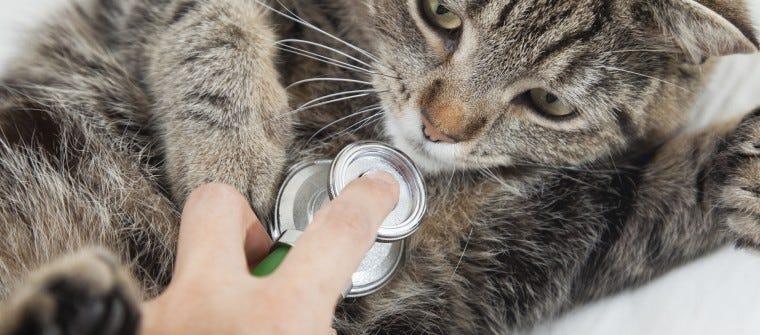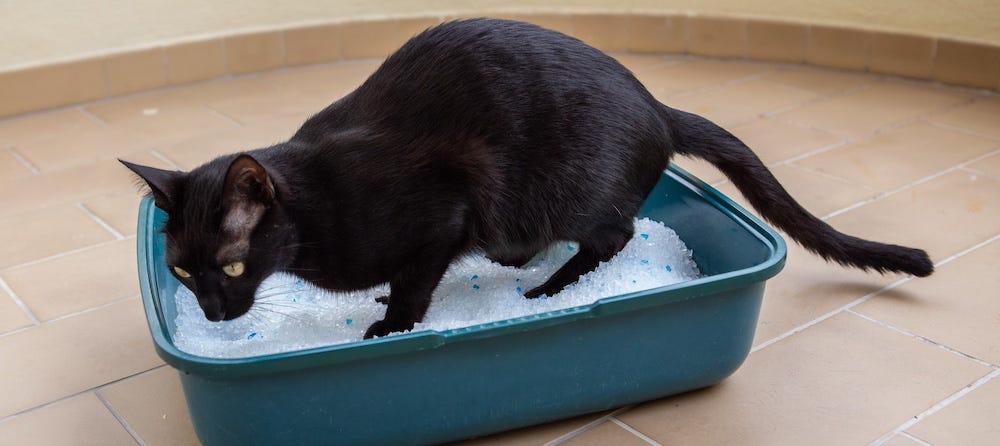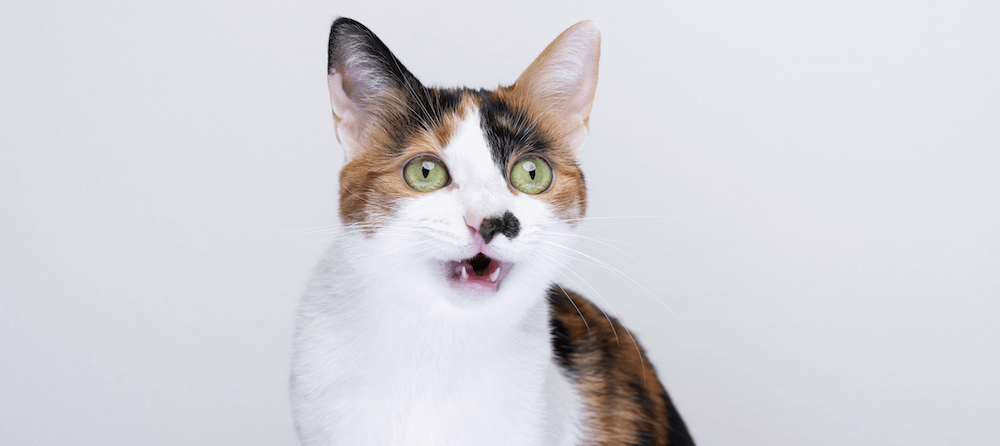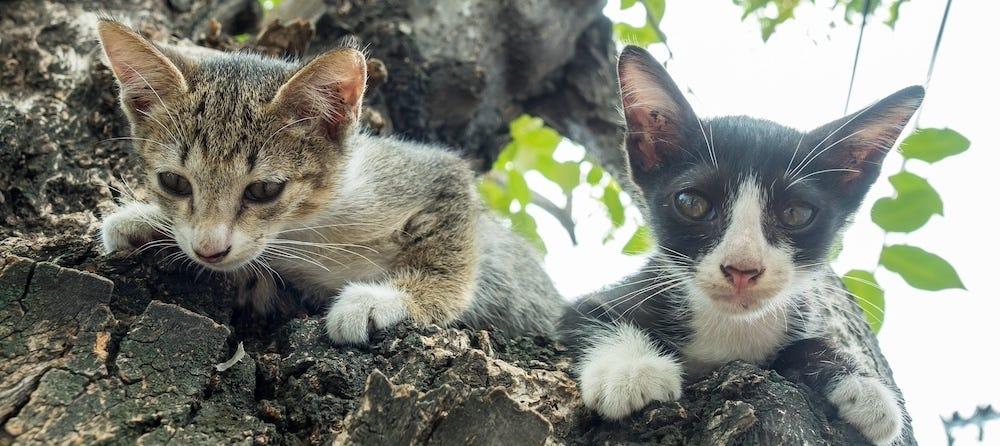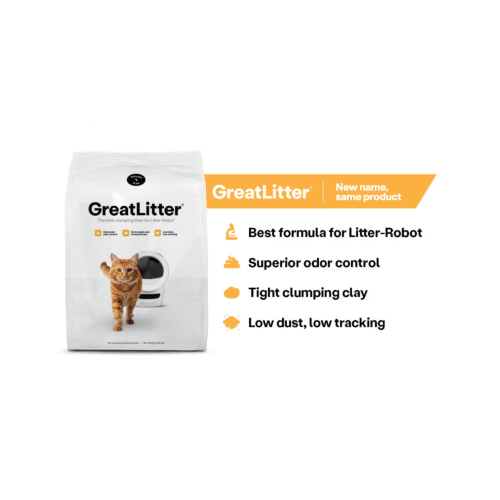Is your cat sneezing? Do you think that your cat has a cold? Well, read on to learn about an upper respiratory infection in cats (more commonly known as the “URI”). In this two-part blog post, I’ll review what you need to know about your cat’s “cold!”
As a heads up, if you just adopted a cat from a shelter (or purchased one from a breeder), you should be aware that your cat will likely break with that dreaded URI—upper respiratory infection—in just a few days.
What is an upper respiratory infection?
An upper respiratory infection in cats is the equivalent of a “common cold” in humans, although the underlying causes are different. Feline upper respiratory infections (URIs) are a common cause of sneezing, fever, runny eyes, and conjunctivitis in cats.
In humans, common colds are typically due to viral infections (which is why you don’t need antibiotics for them!), and are seen more commonly in the winter months (1,2). In cats, URIs are also often due to viral infections; however, they can sometimes be due to bacteria, too (or result in a secondary bacterial infection). Unlike humans, cats are more at risk of developing a URI during the spring and summer. That’s because cats are outside roaming, kittens are born, and more cats are presented to the shelter.
Causes of feline URI include viruses and bacteria, such as:
- Feline calicivirus (FCV)
- Chlamydia, a bacterium
- Feline herpesvirus (FHV-1)
- Rarer bacterial organisms such as Bordatella bronchiseptica or Mycoplasma
Unfortunately, an upper respiratory infection in cats is extremely infectious and contagious, and is more often seen in those living with unsanitary conditions (ineffective disinfection), crowded conditions (shelters, catteries, hoarding situations), stress (outdoor farm cat), immunosuppression (feline leukemia or feline immunodeficiency virus), and more.
How does a cat catch a URI?
So, how does my cat catch a URI? Don’t worry—even though URIs are often from a “herpesvirus,” it’s not sexually transmitted, nor is it contagious to you! Transmission occurs when your cat is exposed to certain bodily fluids (such as discharge from the eyes and nose), and, less significantly, by aerosolization (sneezing) (3). Exposure often occurs when a new cat is brought into an environment. As a result, the other cats in the household may be directly exposed. For example, if you just adopted a kitten, you may find your 10-year-old cat all of a sudden sneezing, too. That’s how contagious it is.
Are certain breeds at increased risk? While no specific breed is at increased risk for URIs, the following are more likely to be exposed:
- Young kittens that are immunosuppressed (due to an immature immune system)
- Cats with underlying infection [e.g., feline leukemia (FeLV), feline immunodeficiency virus (FIV)]
- Feline infectious peritonitis (FIP)
- Cats housed with exposure to other cats (such as shelters, catteries, outdoor feral cats)
Symptoms of an upper respiratory infection
So, what signs is my cat going to show with a URI? With an upper respiratory infection in cats, several organ systems are affected—predominantly the respiratory tract (resulting in sneezing, clear to green discharge from the nose, difficulty breathing, etc.) and the eyes (resulting in runny eyes, squinting, ocular pain, pus from the eyes, conjunctivitis or “pink eye,” and even severe ulceration or injury to the cornea/surface of the eye). Less commonly, the gastrointestinal tract, the skin, the reproductive tract, and the musculoskeletal tract can be affected by URIs (1,2). Typically, when kittens or adult cats are exposed to URIs, it results in a common upper respiratory infection affecting the nose, eyes, mouth, and throat region. This can result in matted-shut eyes and—if untreated—even blindness secondary to severe corneal injury (the clear “surface” part of the eye).
Signs of a URI can be seen within 2-5 days of exposure (1,2), and can take an average of a week or more to go away (3). Note that some cats occasionally have relapses of clinical signs even years later, as the virus is latent (or hides in the body). Just like when you get a cold sore when you’re stressed (from a herpesvirus), you’ll notice it comes back years later when you get stressed again. Well, same with a URI: If your cat was adopted and developed a URI as a young kitten, you may notice the next time something stressful happens—like going on a 5-hour car trip to visit Aunt Mabel—your cat will come back sneezing. That’s how long the virus can potentially hide in the body!
Signs that your cat has a “cold” or URI include:
- Not eating
- Lethargy or not moving much
- Sneezing
- Fever
- Clear to yellow or green discharge from the nose and eyes
- Louder breathing (e.g., snoring-like sounds)
- Increased respiratory effort
- Hiding
- Drooling
- Difficulty chewing food
- Ulcerations on the nose, lips, tongue, and palate
- Conjunctivitis or “pink eye”
- Squinting of the eyes due to corneal ulceration
- Skin irritation near the nose (dermatitis)
- Difficulty breathing due to secondary pneumonia
- Lameness (rare)
- Weight loss
- Dehydration
- Death (rare)
If your cat is eating, drinking, and occasionally sneezing, there is no need to visit the veterinarian. However, if the signs are more severe, and your cat has excessive discharge from the eyes or nose (especially if it’s green or yellow), isn’t eating, is squinting or holding the eyes shut, or is drooling a lot, please get to the veterinarian so that we can treat the URI.
How to diagnose upper respiratory infections in cats
So, you made it to the veterinarian. Before you spend hundreds of dollars on blood work, let’s talk out what your cat will need.
When it comes to diagnosing a URI, there’s no “cheap” or readily available blood test for it. There are specific blood tests (called serologic testing on paired serum samples) that can be used to look for an increase in antibodies to these URI viruses, but this is rarely done due to cost and limited practicality (1,2). Likewise, there are tests to actively detect the URI virus (e.g., immunofluorescent assay) in eye, mouth (e.g., pharynx), or nose scrapings (1,2). Finally, there are smears of the conjunctiva of the eye that can help detect certain cells (e.g., intranuclear inclusion bodies) that are seen with a URI; this is often done by veterinary ophthalmologists to rule out certain eye changes, and is especially important with chronic eye disease (1,2). However, please note that these tests aren’t common and typically should be done by a veterinary specialist.
So, now what? How does your veterinarian make the diagnosis of a URI? It’s typically based on physical examination findings and historical findings (including a history of being recently adopted or purchased, exposure to other cats at a cat show, or history of a “stressful event,” etc.). Blood tests aren’t routinely performed with URIs, unless your cat is sick enough to be hospitalized. If that’s the case, then I do recommend doing a complete blood count and chemistry panel to rule out underlying dehydration, anemia, infection (e.g., an increased white blood cell count), viral infections (FeLV, FIV testing, etc.), or metabolic problems.
How to treat upper respiratory infections in cats
What about treatment? As a veterinarian, there are certain things that I want to treat your cat with when they have signs of a bad URI. And some of these you can implement at home!
While there’s no specific cure for URIs, thankfully, there are supportive things we can do to help make it better. How to treat upper respiratory infections in cats generally includes:
Quarantine
Yes, you heard me right. It’s off to the master bathroom you go. Your newly adopted cat should be kept indoors only and away from the other cats in the house for at least 7 days. This is imperative due to the contagious nature of URIs.
TLC and nursing
URIs cause a lot of eye and nose discharge. Please make sure to keep that discharge away at least 2-3 times per day. You can use a damp terry cloth to blot away any discharge (or even human baby saline wipes). This is important to keep the nostrils open for air exchange and to prevent nasal crusting or blockage.
Humidification
Provide humidified, warm air to allow the nasal passages to stay moist. This can be done best by bringing your cat into the bathroom while you shower (note: not in the shower with you!) or running a humidifier in a small room where your cat sleeps and spends most of his or her time.
Spoiling your cat with tasty food
As cats typically only eat what they can smell, microwaving the food for a few seconds (making sure it’s not too hot to the touch) can help enhance the smell and palatability. Splurge on some tasty canned food to encourage your cat to eat. (FYI, you don’t need to buy expensive brands—it seems the cheaper the brand, the more they enjoy that can!)
Eye medication
If corneal ulcers or conjunctivitis is present, topical antibiotic ointments or drops (e.g., terramycin, oxytetracycline, erythromycin, etc.) for the eye may be necessary. In severe cases, topical anti-viral ointments can also be used (e.g., cidofovir, etc.), however these are generally very costly. Never use expired medications without talking to your vet. And don’t use your other pet’s eye meds. As a veterinarian, we need to see what the drug ingredients are and want to make sure it’s the correct medication, as certain drugs can make the eyes WORSE! For example, don’t use eye drops containing steroids, as this may make your cat’s URI eye changes even more severe.
Antibiotics
Sometimes, a secondary bacterial infection may occur (as evidenced by green, pus-colored discharge from the eyes or nose). In this case, oral antibiotics may be necessary. Note: As the most common cause for URIs are viral in origin, antibiotics are typically not warranted unless there is a secondary bacterial infection (just like human colds that do not typically require antibiotics). Keep in mind that antibiotics can often cause cats to lose their appetite, or develop vomiting and diarrhea. If antibiotics are necessary, doxycycline is often used to treat secondary bacterial infections (e.g., Chlamydophila) until clinical signs resolve. Also, if you can’t pill your cat, this can be more stressful to your cat! Talk to your veterinarian about a long-acting antibiotic shot under the skin, Convenia™, that lasts 7-10 days so you don’t have to pill your cat.
Subcutaneous fluids
If your cat is dehydrated, we can give fluids under the skin to help hydrate your cat, which will make him or her feel better.
Lysine
Lysine, a supplement, can be considered to help with URIs, as it is generally considered to be very benign; however, recent literature has found this to be ineffective with URIs. My general advice? If your cat loves to lick lysine out of the tasty tube, go for it. But if it’s stressful to pill him, it’s not scientifically worth it.
Hospitalization
In severely affected cats, hospitalization for intravenous (IV) fluids, IV antibiotics, oxygen, supportive care (including nebulization, humidification, heat support), and a temporary feeding tube may be necessary.
How to prevent upper respiratory infections in cats
Lastly, how do I prevent my cat from getting a URI?
- Appropriate isolation: If you just adopted a new kitten, that kitten should be isolated into a separate area (such as the bathroom) away from the other house cats for at least 7-10 days. This will allow time for acclimatization and responding to treatment, if indicated, as well as prevent spread of infection.
- Appropriate vaccination protocols: Work with your veterinarian to make sure your kitten or cat is healthy, and is up-to-date on vaccines. URIs can be potentially minimized by appropriately vaccinating. However, vaccines will not prevent the latent stage (or “carrier” stage) of URI complex. It will, however, minimize the severity and longevity of the URI disease process. That said, unfortunately, many kittens and cats that are in catteries or shelters may be exposed to URIs prior to vaccination, resulting in a chronic environmental problem within that facility.
There are two main types of vaccines that are used: Intranasal and injectable (under the skin) (1,2).
- The intranasal is typically only used in young kittens (around 10-14 days old). The benefit of intranasal vaccines is that it takes effect very quickly and works locally (within the nares). Rare side effects include the development of mild signs of a URI from the vaccine (such as nasal discharge, sneezing, etc.).
- The injectable vaccine is used more commonly in older kittens and cats, but takes longer to mount an immune response.
When in doubt, the prognosis for feline upper respiratory infections is good with supportive care. Treatment by your veterinarian may be necessary, depending on the severity of clinical signs. When in doubt, a veterinary exam is a must in a newly adopted or purchased cat.
References
- Scott FW. Feline Calicivirus Infection. In Blackwell’s Five-Minute Veterinary Consult: Canine & Feline. Eds. Tilley LP, Smith FWK. 2007, 4th ed. Blackwell Publishing, Ames, Iowa. pp. 476-477.
- Norsworthy GD. Feline Rhinotracheitis Virus Infection. In Blackwell’s Five-Minute Veterinary Consult: Canine & Feline. Eds. Tilley LP, Smith FWK. 2007, 4th ed. Blackwell Publishing, Ames, Iowa. pp. 496-497.
- Feline Upper Respiratory Infection. Accessed December 1, 2013 at: http://www.sheltermedicine.com/node/45
